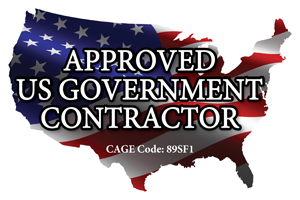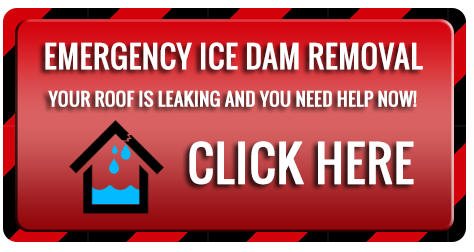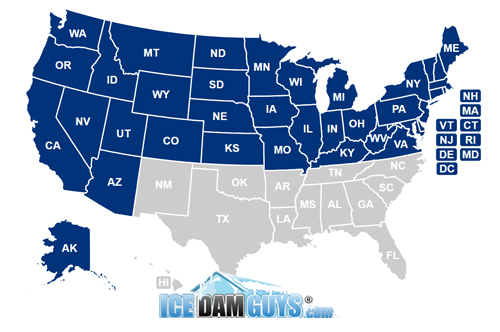Attic Condensation: a Silent Cause of Winter Roof Leaks
If you have a roof-leak in the winter months and it’s not being caused by ice dam, there may be another culprit: attic condensation. The conditions that cause ice dams often cause attic condensation, too.
You may pay an ice dam removal company to melt the ice dam off your roof, only for the leaking to continue. The problem no longer will be the ice on your roof, or any source of water leaking into your home from the outside. Rather, what you’ll discover is an inside job: The problem may be water vapor from inside your home, which has snaked its way into your attic. As the warm vapor cools, the moisture coalesces into big, damaging droplets all over the wooden surfaces in your attic. Picture a cold glass of water in the summer. That’s the interior of your attic. Eventually, enough condensation can cause visible leaks, rot, mold, and a host of other problems.
What causes attic condensation? First, warm and moist air rises up from the living space below, and gets trapped in your attic space. If it’s winter and it’s much colder outside (as is often the case), when that warm moist air comes in contact with the cold underside of your roof deck, you get condensation. (Remember the example of the cold glass in the summer?) Condensation is simply the result of water in a gaseous state (that is, vapor) being converted to its liquid state as it cools. It’s one principle that allows air conditioners to work. But you don’t want it in your attic!
What should you do about attic condensation? First and foremost, you need good insulation in your attic, so as to minimize the amount of warm air that wafts up there. The key to doing that is to make sure your attic bypasses – places with no insulation or not enough insulation – are sealed or insulated properly. That will minimize the amount of warmth that seeps into your attic every time you blast up the heat from the comfort of your living room.
You may have other problems. Your heating ducts may run straight through your attic, and if that duct isn’t insulated, it will transfer some of that heat into the attic by warming the air surrounding your uninsulated ductwork.
Your exhaust fans may vent the wrong way – into the attic instead of outside.
Those potential problems may add up to a lot of warm air. Your bathroom, in particular, is a great source for moist air, since you’re in there taking hot, steaming showers and then venting all of that steam right into your attic every time you run the fan. You’re venting it into your attic even if you don’t run the fan, as it finds its way through bypasses and/or the vent itself.
You may be able to counteract some of the attic condensation issue by installing a whole-home dehumidifier. But drying out the air will only accomplish so much. A warm attic is a warm attic. There will always be some water vapor on your little patch of the 75-percent-water Earth.
Also, it should go without saying that a dehumidifier won’t help one pinch to prevent ice dams.
Now you may be thinking, “Yeah, but I rake my roof specifically so I don’t get ice dams, and I don’t want to spend the money on all that insulation. I’ll just stick it out.”
Keep in mind that water damage caused by attic condensation can be just as harmful to your home as ice dam leaks are – sometimes even worse. An ice dam leak is a royal pain. It often times rains down from your ceiling, it soaks your walls, and it may send sheetrock crashing onto your coffee table. Because it’s so noticeable, you’re more likely to want to clean it up right away, and maybe even to take care of the underlying causes.
Attic condensation is slower, quieter, more nefarious, and less obvious. Your roofing beams may slowly rot away and develop mold that can spread into the rest of your home. It’s out of sight and out of mind until your roof starts sagging and you develop respiratory problems. And that’s before you pay the repair bills (more on those in a minute).
It’s a shame to do everything you can do to prevent ice dam damage by standing out there with your roof rake, paying for snow removal, and calling for ice dam removal at the right time – only to end up paying for water damage remediation anyway because you kept putting off the energy audit and updates that could have prevented both problems.
Schedule a home energy audit, and make the suggested updates. It’s as simple as that.
The average cost to insulate an attic is about $1355. The great cost of water damage is a combination of high costs: mold remediation ($3000), roof beam repair ($1362), roof repair if you get ice dams ($1000) sheetrock repair ($550), and replacement for water-damaged carpet ($995). On average, it comes out to $6907. Ow. And these numbers are “best case scenario.” The actual cost of repairs could turn out to be double, triple, or even quadruple these averages!
Compared to that menu of pain, getting the energy audit and fixing the insulation doesn’t seem so bad anymore. I’d argue that it’s just financial common-sense.
By the way, attic condensation can dog even a newer home. Building codes don’t really address humidity issues as well as they should, and they don’t require enough insulation to begin with. The Minnesota building code demands R-49 insulation, even though it takes R-60 insulation to really give you the protection you need (in my opinion). Building codes also don’t always address attic bypasses, insulation on heating ducts, or exhaust fans that push hot air into the attic.
I can’t complain too much, because if every house was well-insulated I wouldn’t have much of an ice dam removal business. That doesn’t mean your home should be the one with the problems, though, so my advice is to go heavy on the insulation.
In fact, if you live in a “new build” subdivision, a place where people tend to get complacent because everything looks so shiny and new, you may want to be even more careful than you’d be if your home was older. Builders often make poor (but legal) choices in the name of keeping costs down.
Get the energy audit! You can thank me later.






















